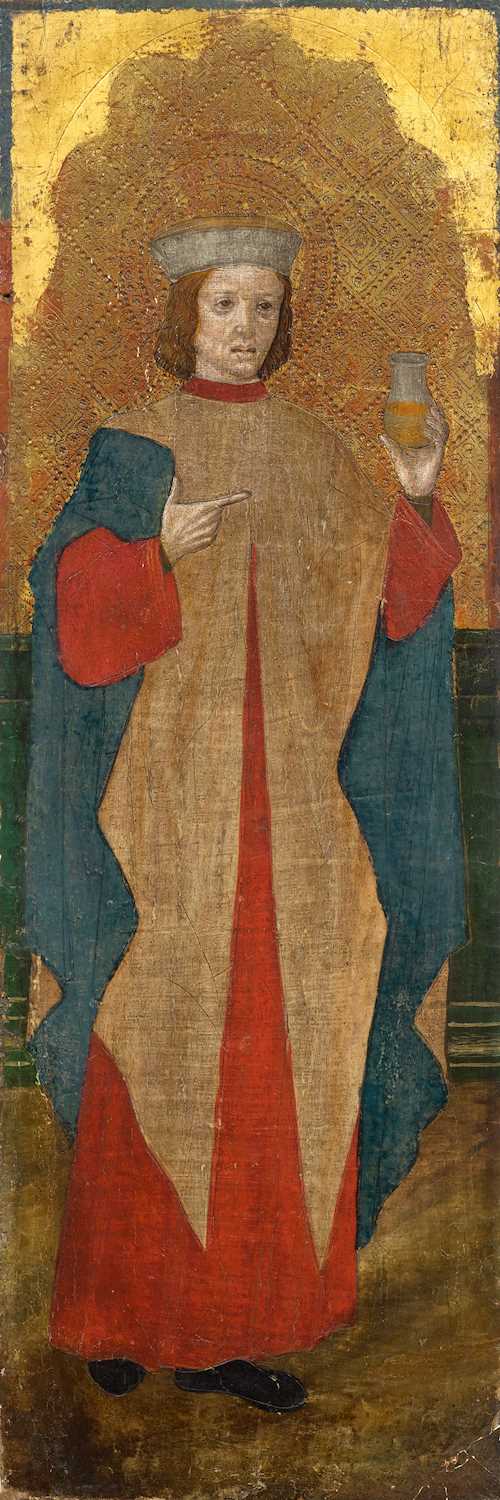
Lot 3003 - A200 Old Master Paintings - Friday, 01. April 2022, 02.00 PM
MILAN, CIRCA 1470–80
[Art.ArtText.Text@@1('[Art.BoId],21')]
[Art.ArtText.Text@@1('[Art.BoId],22')]
[Art.ArtText.Text@@1('[Art.BoId],23')]
[Art.ArtText.Text@@1('[Art.BoId],24')]
[Art.ArtText.Text@@1('[Art.BoId],25')]
Private collection, Switzerland.
These two intricate paintings depict the two Arabian physician-saints Cosmas and Damian, wearing the headdress and long robes typical of their profession. According to legend, these early Christian twin brothers were healers who treated the sick free of charge and converted many of them to Christianity. The former can be recognised by the glass urine vial in one hand, the latter by the box of medicines and a thin instrument with which he mixes healing powders. The two saints are depicted in front of a parapet and against the background of a magnificent gilded surface stamped with a refined geometric motif; a very similar motif adorns the gilt background of of a pack of playing cards attributed to Bonifacio Bembo (1447–1477), forty-eight of which are conserved in the Pinacoteca di Brera.
It is entirely possible that the small polyptych contained at least two other figures of saints on the sides, all set in a richly gilded frame, as suggested by the two multi-lobed upper borders of the painted surfaces. It should also be noted that the design of the saints’ figures was almost certainly engraved on the chalk preparation of the panels before the colours were applied.
The two paintings can be convincingly compared with some of the figures of saints on the walls of the Ducal Chapel in the Castello Sforzesco. As is well known, the murals in the chapel were rapidly executed between 1472 and 1473 by a group of painters under the direction of Bonifacio Bembo, according to an iconographic scheme by the Augustinian monk Paolo da San Genesio, the Duke’s confessor: the Resurrection of Christ on the vault, the Annunciation and heraldic coats of arms in the lunettes, and on the walls a series of saints depicted in a similar arrangement to the two panels. As Marco Albertario has made clear (see Documenti per la decorazione del Castello di Milano nell'età di Galeazzo Maria Sforza (1466–1476), in: Solchi, vol. 7, 2003,1/2, pp. 19–61; Ad nostro modo': la decorazione del castello dell'età di Galeazzo Maria Sforza (1466–1476), in: Il Castello Sforzesco di Milano, ed. by M. T. Fiorio, Milan 2005, pp. 99–134), payments for the decoration of the chapel were made not only to Bembo (the court painter of the time) but also to other artists, including Stefano de Fedeli (2nd half of the 15th century), Giacomino Vismara ‘et compagni dipintori’. However, the vagueness of the documents does not allow us to distinguish with certainty the different hands that worked on the walls of the chapel.
The figures of Saint Albert and the remains of a deacon (Lorenzo?), which are particularly close to those of the two saints, should also be considered in this context. This is particularly noticeable in the overall design as well as in the lines on the faces. The painting with the members of the Confraternity of the Blessed Sacrament visiting a sick person (panel, 78 × 51 cm), found in the Basilica of San Lorenzo in Milan, has even more similar features. In this case, the statuesque and delicate immobility of the figures, the luminous painting and the subtle and linear graphic signs identified by Miklós Boskovits (see The Martello collection. Further paintings, drawings and miniatures, 13th –18th century, ed. by M. Boskvits, Florence 1992, pp. 28–35, with an attempted attribution to Ambrogio Bevilacqua) are consistent with the technical and formal characteristics of the two saints, which appear to have been painted by the same master.
This small group of works, which can be dated to the years between 1470 and ca. 1480, illustrates a phase of Milanese painting characterised by slender, luminous figures with an almost miniaturistic execution, inspired on the one hand by the frescoes of Vicenzo Foppa (1427–1516) in the Portinari Chapel in Sant'Eustorgio (c. 1468) and on the other by the wall paintings in the Ducal Chapel: a transitional phase of Lombard painting, which includes the triptych of the Madonna of Mercy by Gottardo Scotti (active 1457–1481) in the Museo Poldi Pezzoli in Milan (inv. no. 1633/685).
CHF 20 000 / 30 000 | (€ 20 620 / 30 930)
Sold for CHF 24 700 (including buyer’s premium)
All information is subject to change.

